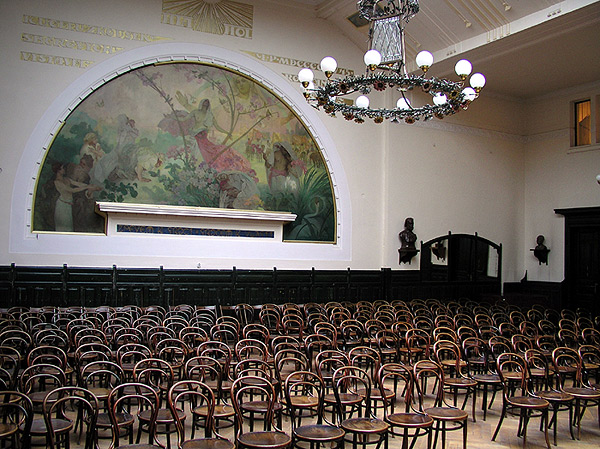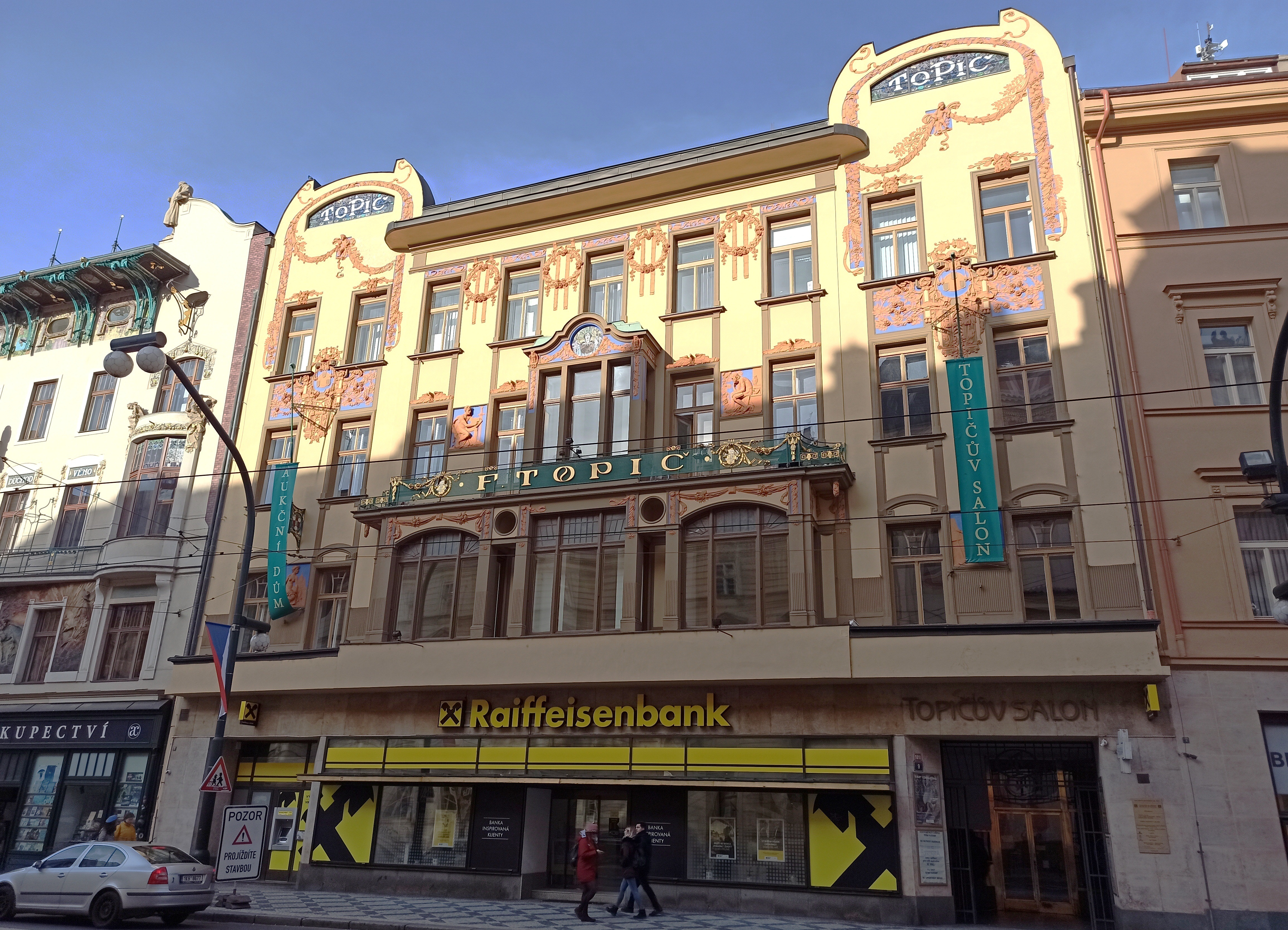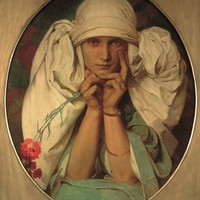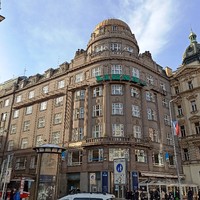Breadcrumbs navigation
I. Getting in step with Mucha’s designs
Walking route: Masaryk embankment – Hlahol Association House – National Theatre – Topič Salon – Národní třída – Wenceslas Square – Vodičkova street – Mucha Museum
On this route you will follow the footsteps of Alphonse Mucha in the New Town of Prague. From Jiráskovo square you will walk along the Vltava river to the Hlahol Association House, where a sizeable Mucha canvas still hangs. From there, the route continues along places connected with Mucha’s personal and professional life to the National Theatre, where he first met his future wife, to the Topič Salon, where the first Prague exhibition of his works took place, then to the studio where he made the designs for the famous Slav Epic, finishing off the walk at the Mucha Museum.
Masaryk Embankment – Hlahol Association House
From the Jiráskovo náměstí stop you can take a walk along the Vltava river. The Masaryk Embankment is itself a showcase of Historicist and Art Nouveau buildings from the turn of the 19th and 20th centuries, built here as part of the project to contain the Vltava riverbanks and redevelop the old waterfront buildings. One of the true gems of Prague’s Art Nouveau architecture is the Hlahol Association House (Masarykovo nábřeží 16), where the choral association of that name (“hlahol” means the sound of resounding, ringing-out) is still based today. The Hlahol Association was founded in Prague in 1861, first as a male voice choir, but from 1879 grew to include a female choir.
The building was built to the design of arch. Josef Fanta in 1903-1905. In addition to the much-prized architecture, it is also worth seeing the interior of the building, with many original Art Nouveau features, fittings, chandeliers and doors still preserved. One of the gems is Mucha’s large lunette canvas on the theme of Song – an allegory of singing, which the painter began in 1921 and worked on for 13 years. Today, the canvas is situated in the great hall on the ground floor of the building. In a landscape steeped in rosy light are depicted several figures: ‘A National Song as attended by chirping birds, a Lullaby of Maternal Love, personified Love for the Homeland, personified Prague and her being lauded by numerous heralds.’ (Citation provided by the Mucha Foundation)

You will carry on along the Masaryk Embankment, where just a few blocks away is another pearl of Prague Art Nouveau architecture, the Goethe Institute, built in 1905 to the design of arch. Jiří Stibal.
The National Theatre
You are just a few steps away from the National Theatre, a showy neo-Renaissance building on the corner of Masaryk Embankment and Národní třída boulevard. Its construction became a symbol of the cultural revival of the Czech nation and its décor a showcase of romanticizing paintings and sculptures in Bohemia. Construction began in 1868, the theatre was inaugurated for the first time in 1881 (and after it caught fire, once again in 1883). A number of the leading artists of that time participated in the decoration, and were to become known as the National Theatre generation: the sculptors Josef Václav Myslbek and Bohuslav Schnirch as well as the painters Mikoláš Aleš, František Ženíšek, Václav Brožík or Julius Mařák. During the Auguste Rodin exhibition in Prague in 1902, the accompanying cultural events programme for the French delegation also included a visit to this symbol of national revival. Alphonse Mucha was present with Rodin that evening, and this was to be a turning-point in his life. It was here that he was first seen by his future wife Marie Chytilová, a student of applied art with whom he became close a year later after he took her on as his pupil in his Parisian studio. Three years after that, in 1906, they married.
Topič Salon – Národní třída
On the opposite side of Národní třída nearby are two buildings rebuilt in the Art Nouveau style to the architectural project of Osvald Polívka – the first one, inscribed Pojišťovna Praha was built in 1906-7, the neighbouring house with the inscription F. Topič in 1905-6.
At the turn of the 19th and 20th centuries, increasingly renowned exhibitions of modern art were held under the ‘Topič Salon’ moniker at the present-day Art Nouveau building of Pojišťovna Praha, The publisher and leading light of book culture, František Topič, had an exhibition hall built for these purposes in the courtyard of the building. In 1897 it housed a travelling exhibition by Alphonse Mucha, en route from Paris to many world capitals. It was Mucha’s first solo exhibition in Prague and the first exhibition of Art Nouveau in Prague. Showing at that time, among other things, were the posters he created for Sarah Bernhardt, the very works that made Mucha famous (Gismonda, Lorenzaccio and others). In addition to his posters, Mucha’s book illustrations were also shown. In 1905, the Topič publishing house and art salons moved to the premises of the adjacent Art Nouveau building.

Let us proceed along Národní třída to No. 28. Just where the current neoclassicist building now stands used to be a Baroque house from the first half of the 18th century, called U Choděrů – after a local and much acclaimed restaurant. In this house, specifically in the Rubeš Salon, an exhibition of Mucha’s drawings was held from 4 June to 4 July 1915. The building was demolished in 1920 to meet building regulations.
Wenceslas Square – Vodičkova street
Going on, the route of our walk leads straight along ‘28th October street’ to Můstek and from there we’ll take a right, up Wenceslas Square. Roughly in the middle of the square, at Vodičkova street, stands the Ligna Palace building, which originally housed the Czech Bank. The palace in the style of late Art Nouveau Neoclassicism was built in 1914-16 to the design of architects Josef Sekař and Osvald Polívka.
On the top floor of the building used to be Mucha’s studio during the First Republic period; the artist worked here on smaller commissions, such as designing stamps or banknotes. However, his first sketches for the Slav Epic were also created here. Mucha’s daughter Jaroslava remembers how she posed for her father’s first Czechoslovak ten-crown banknote design in this very studio.
Alphonse Mucha’s tireless diligence is also illustrated by the fact that he was fully preoccupied painting his daughter for so long that she fainted and passed out in the sweltering summer heat. In order to atone for his daughter’s suffering, and reward her for her literally exhaustive cooperation, he then took her to the famed Myšák confectionery, for her beloved strawberry ice cream. This café and patisserie is still standing, a few blocks away in the Rondocubist house at Vodičkova street 31.
The Mucha Museum – saving the best till last!
From Vodičkova street we’ll cross to the opposite side of Wenceslas Square, to Jindřišská street, and then go left along Panská street, where in house No. 7 you can visit the Prague Mucha Museum.

The museum presents the artist’s complete works in seven thematically arranged units. In the first part, called the decorative panneau, you can see how Mucha’s style developed. In the second part, you will get acquainted with the posters he created in Paris in the 1890s, for Sarah Bernhardt, among others. The third part deals with Mucha’s decorative designs for jewellery, furniture and other objects of applied art. The fourth section presents his posters for Czech associations such as Sokol, and others. The fifth section presents Alphonse Mucha as a painter. Here you can see primarily his oil paintings, which culminated in the famous Slav Epic. The sixth part shows his drawings and pastels, and the final seventh part presents the artist’s life in photographs and personal items.
Route map
1. Jiráskovo náměstí tram stop
2. Masaryk Embankment
3. Hlahol Association House (Masarykovo nábřeží 16)
4. National Theatre
5. Topič Salon (Národní 9)
6. 28 října street
7. Můstek
8. corner of Wenceslas Square and Vodičkova street - Ligna Palace building
9. Myšák confectionery (Vodičkova 31)
10. Mucha Museum (Panská 7)
TIP: Head to the Waldstein Riding School and visit the exhibition "Mucha: The Family Collection", presenting the artist's works in a way he has never been presented before.


